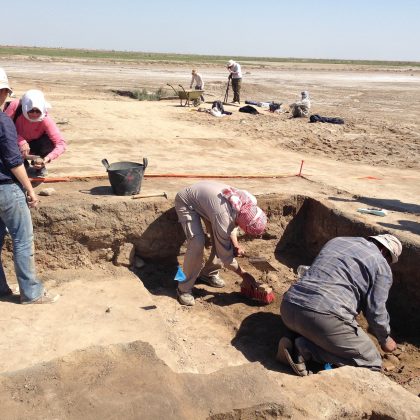The ancient history and heritage of the Mosul region: an A–Z, Part I
Eleanor Robson, Editor of Iraq
Over the past few months, the Iraqi armed forces and their allies have freed substantial areas of northern Iraq from ISIS/Da’esh, liberating many hundreds of thousands of people from the terrorists’ control. The focus of their efforts is Mosul, a city which has been inhabited for around five thousand years. East of the river Tigris the landscape is dominated by the walls and palaces of Nineveh, capital of the great Assyrian empire in the 7th century BCE. On the west bank, the medieval city of the Zangid dynasty (1127–1259 CE) is densely packed with synagogues, churches, mosques, and other important heritage buildings. Monasteries, Yezidi shrines, and important archaeological sites are also scattered through the surrounding towns and countryside.
Over the past 2 ½ years ISIS/Da’esh has inflicted systematic damage to Mosul’s heritage infrastructure. Beyond their videoed destructions at Mosul Museum and the Assyrian city of Nimrud, they have desecrated or demolished many buildings that offended their narrow religious sensibilities, and looted archaeological sites. The current bombing campaign in the war against ISIS is also doing untold harm, especially to west Mosul. Recently liberated archaeologists and archivists are now starting to document what has gone, and what is still at risk.
Iraq has been publishing Iraqi and international research on the cultural heritage of the Mosul region ever since the journal was founded in the 1930s. To celebrate its new-found freedom, and in support of the intense programme of assessment, planning and restoration that is now beginning, I have chosen 26 articles from past volumes to showcase the amazing richness of Mosul’s history and heritage, from A-Z.
Adiabene
After the fall of Nineveh, after the collapse of Seleucid rule, the kingdom of Adiabene formed in the Mosul region in the 2nd century BC. This very recent article contrasts the self-portrayals of Adabenian kings with how the Romans pictured them.
- Michał Marciak and Robert S. Wójcikowski, Images of Kings of Adiabene: Numismatic and Sculptural Evidence
Behnam Abu Al-Soof (1931–2012)
In the 1959–60 Iraqi archaeologist Behnam Abu Al-Soof excavated and restored the famous throne-room of Assyrian king Assurnasirpal’s Northwest Palace in Nimrud (c.860 BC). This obituary by his PhD supervisor Dr Joan Oates lovingly recounts his impressive life and work.
- Joan Oates, Behnam Abu Al-Soof, B, PhD (1931–2012)
Churches
Christianity established itself very early in northern Iraq. Here St John Simpson discusses the complex history of a building west of Mosul, founded as a church in the a 6th century CE.
- St John Simpson, Note on Qasr Serij
Divinity
In this classic article, W.G. Lambert explains why the Assyrian god Aššur was conceptualised so differently to the other gods in the Mesopotamian pantheon. It made good sense of a lot of previously confusing evidence.
- W.G. Lambert, The god Aššur
Ekal māšarti
The Ekal Mašarti, the Assyrian ‘review palace’ at Nineveh, has been much in the news in early 2017. Iraqi archaeologist Layla Salih has documented ISIS’ looting and damage to this important, unexcavated site under the muslim shrine of Nebi Yunis (the prophet Jonah). Geoffrey Turner’s survey of the archaeological and textual evidence for the Ekal Māšarti is still very useful today.
- Geoffrey Turner, Tell Nebi Yūnus: the Ekal Māšarti of Nineveh
Fieldwork
Archaeology has traditionally focused on the excavation of single sites. Tony Wilkinson pioneered a much broader concept of fieldwork that encompassed large landscapes over long spans of time, as seen from the ground and from the air.
- T.J. Wilkinson, The Development of Settlement in the North Jazira between the 7th and 1st Millennia BC
Games
Board games have an eternal allure. As, this little article from Iraq’s very first issue shows, Assyrian king Esarhaddon (r.681–669 BC) had a particular penchant for the Egyptian game “58 holes”.
- C. J. Gadd, An Egyptian Game in Assyria
Harp
We will never quite know what ancient Assyrian music sounded like, but official images in palaces show that it played an important role in royal ceremonies. In this recent article Jack Cheng investigates the symbolic significance of the Assyrian harp.
Imgur-Enlil (Balawat)
Imgur-Enlil, on the modern site of Balawat, was a summer residence of the Assyrian kings. Here epigrapher Barbara Parker gives a first reading of the cuneiform tablets excavated there in 1957, which hint at the tribulations of everyday life in the town in the early first millennium BC.
- Barbara Parker, Economic Tablets from the Temple of Mamu at Balawat
Parts II and III of this blog will highlight further articles on the Mosul region’s rich cultural history, covering the letters J–Z.
Read all the articles featured in this post free on Iraq‘s homepage.





